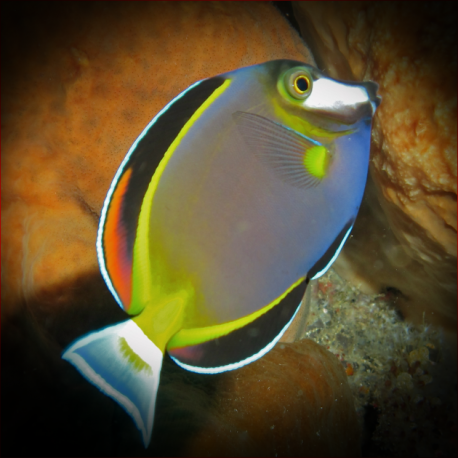More info
Datasheet
| Minimum Tank Size | 500 litres / 132.09 US gallons |
| Maximum Size | 21cm / 8.27inches |
| Reef Compatible | Always reef safe |
| Temperament | Docile but might be aggressive towards similar species |
| Temperature | 22.2°C / 71.96°F - 25.6°C / 78.08°F |
| Specific Gravity | 1.020-1.025 |
| Carbonate Hardness | 8-12 |
| pH | 8.1-8.4 |
General Description
The Japan surgeonfish, scientifically known as Acanthurus japonicus, is a member of the Acanthuridae family. These fish are known for mimicking different types of Angelfish as juveniles to evade predators, making them challenging to identify in adulthood. Surgeonfish primarily feed on various types of algae and possess a sharp scalpel near their caudal fin for self-defense. They are typically peaceful towards other fish but may establish a hierarchy when kept in groups.
Aquarium Suitability
The Japan surgeonfish is suitable for aquariums with proper care due to its delicate nature. These fish have specific demands for tank size, water quality, and surroundings. They require a minimum tank size of 500 liters, good hiding spots, and ample space for swimming. Being docile, they should not be housed with more aggressive tank mates. Additionally, they thrive in well-established aquariums with abundant algae for grazing.
Demands, Care, and Hardiness
Japan surgeonfish have higher demands for tank size, water quality, and surroundings compared to some other fish species. They are delicate and sensitive, especially during transportation and acclimatization. It is crucial to provide a well-run aquarium with algae-rich rocks and supplement their diet with algae-based foods to maintain their health. These fish also need good hiding places in the aquarium.
Reef Suitability
The Japan surgeonfish is always reef-safe and generally does not irritate corals or invertebrates. However, large Palettes/Blue tangs may be exceptions to this behavior. When placed in a reef environment, these fish spend their time swimming around and nibbling on algae, contributing to keeping the tank free of excessive algae growth.
Aquarium Setup
For setting up an aquarium for Japan surgeonfish, ensure a tank size of at least 500 liters with plenty of hiding places among live rocks. Maintain stable water conditions with a pH of 8.1-8.4, a specific gravity of 1.020-1.025, and a temperature range of 22.2-25.6°C. Provide algae-rich food such as seaweed or spirulina and ensure the tank is well-established with sufficient algae for grazing.
Behaviour
The Japan surgeonfish is known for its shy and docile demeanor. When kept in a community tank, they may exhibit aggression towards similar species, especially when establishing a hierarchy. It is essential to observe their behavior closely, particularly when introducing new fish or during feeding times.
Feeding and Diet
This species primarily feeds on small crustaceans like krill, mysis, and artemia but also requires an algae-based diet for optimal health. Feeding them macroalgae such as seaweed or nori, and microalgae like spirulina helps boost their immune system and overall well-being. Ensuring a proper diet is crucial for keeping these fish healthy in captivity.
Dimorphism
Dimorphism information is not specified.
Habitat and Distribution
The Japan surgeonfish, native to the Indo-West Pacific region from Sulawesi to the Philippines and Ryukyu Islands, inhabits coral reef environments. They are often found swimming around rocks and stones, grazing on algae and contributing to the ecosystem by keeping algae growth in check.

